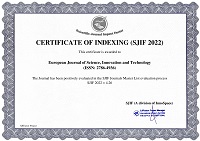Differentiation of Monkeypox from Other Poxes Using Local Interpretable Model-Agnostic Explanation and Deep Learning Algorithm
Abstract
While still trying to recover from the harm brought by COVID-19, the pox virus, particularly MPox (Monkeypox), now poses a fresh threat of spreading to the entire world. Skin lesions and rashes caused by Mpox are similar to such caused by other pox diseases such as chickenpox and cowpox and these medical and visual resemblances of several pox diseases make it difficult for healthcare providers to establish an early diagnosis leading to inefficient control of the disease's transmission within a community. In image-based diagnostics, deep learning has shown enormous potential. However, there exist the challenges of complexity of the model and lack of understanding of the prediction parameters for making classification and inference. In this research, a machine learning approach for the classification of Mpox from other pox diseases is proposed. The dataset was created by compiling images from open-source and internet resources that place no limitations on usage. Three models were proposed and evaluated: the CNN model, ResNet50, and EfficientNetNB. Two of the models were pre-trained models while the CNN model was developed completely new. During testing, the CNN model was the best-performing model outperforming state-of-the-art pre-trained models. Our experimentation using the test dataset indicated that our Convolutional Neural Network (CNN) model can identify six classes of skin images with 99% accuracy, 98% precision score, 99% recall, and 98% F1 score. The AUC score of our CNN model was obtained as 99%. Finally, the use of Local Interpretable Model-Agnostic Explanations (LIME) was used to provide meaningful insight into how the CNN the best-performing model among the three arrived at a particular decision based on the extracted feature from the input data.
References
Ahmad, M. A., Eckert, C., & Teredesai, A. (2018, August). Interpretable machine learning in healthcare. In Proceedings of the 2018 ACM international conference on bioinformatics, computational biology, and health informatics (pp. 559-560).
Ahsan, M., Uddin, M., Farjana, M., Sakib, A., Momin, K., & Luna, S. (2022). Image data collection and implementation of the deep learning-based model in detecting mpox disease using modified vgg16. arXiv preprint arXiv:2206.01862.
Ali, S., Ahmed, M., Paul, J., Jahan, T., Sani, S., Noor, N., & Hasan, T. (2022). Mpox skin lesion detection using deep learning models: feasibility study, arXiv preprint arXiv:2207.03342.
Allugunti, V. (2022). Breast cancer detection based on thermographic images using machine learning and deep learning algorithms. Engineering in Computer Science, 4(1), 49-56.
CDC (2022). Monitoring People Who Have Been Exposed. Retrieved October 4, 2022 from https://www.cdc.gov/poxvirus/mpox/ clinicians/monitoring.html.
Das, D., Ito, J., Kadowaki, T., & Tsuda, K. (2019). An interpretable machine learning model for diagnosis of Alzheimer's disease. PeerJ, 7, e6543. https://doi.org/10.7717/peerj.6543.
Ekong, A. (2023). Evaluation of machine learning techniques towards early detection of cardiovascular diseases. American Journal of Artificial Intelligence, 7(1), 6-16.
Ekong, A., Ekong, B., & Edet, A. (2022). Supervised machine learning model for effective classification of patients with Covid-19 symptoms based on Bayesian belief network. Researchers Journal of Science and Technology, 2022(2), 27 – 3.
Ekong, A. P., James, G. G., & Ohaeri, I. (2024a). Oil and gas pipeline leakage detection using IoT and deep learning algorithm. Journal of Information Systems and Informatics, 6(1), 421-434.
Ekong, A., Attih, I., James, G., & Edet, U. (2024b). Effective classification of diabetes mellitus using support vector machine algorithm. Researchers Journal of Science and Technology, 4(2), 18-34.
Ekong, A., James, G., Ekpe, G., Edet, A., & Dominic, E. A. (2024c). Model for the Classification of Bladder State Based on Bayesian Network. International Journal of Engineering and Artificial Intelligence, 5(2), 33-47.
Fujita, H. & Cimr, D. (2019). Computer Aided detection for fibrillations and flutters using deep convolutional neural network. Information Science, 486, 231–239.
Gao, J., Jiang, Q., Zhou, B., & Chen, D. (2019). Convolutional neural networks for computer-aided detection or diagnosis in medical image analysis: An overview. Mathematical biosciences and engineering: MBE, 16(6), 6536–6561. https://doi.org/10.3934/mbe. 2019326
González-Díaz, I. (2019). DermaKNet: Incorporating the Knowledge of Dermatologists to Convolutional Neural Networks for Skin Lesion Diagnosis. IEEE Journal of Biomedical and Health Informatics, 23(2), 547-559. doi: 10.1109/JB-HI2018.2806962.
Hosseini-Asl, E., Ghazal, M., Mahmoud, A., Aslantas, A., Shalaby, A., Casanova, M., Barnes, G., Gimel'farb, G., Keynton, R., & El-Baz, A. (2018). Alzheimer's disease diagnostics by a 3D deeply supervised adaptable convolutional network. Frontiers in bioscience (Landmark edition), 23(3), 584–596. https://doi.org/10.2741/4606
James, G. G., Okpako, A. E., Ituma, C., & Asuquo, J. E. (2022). Development of Hybrid Intelligent based Information Retreival Technique. International Journal of Computer Applications, 975, 8887. doi: 10.5120/ijca2022922401.
James, G., Ekong, A., & Odikwa, H. (2024a). Intelligent model for the early detection of breast cancer using fine needle aspiration of breast mass. International Journal of Research and Innovation in Applied Science, IX (III), 348-359. doi: 10.51584/IJRIAS.2024.90332.
James, G. G., Oise, G. P., Chukwu, E. G., Michael, N. A., Ekpo, W. F., & Okafor, P. E. (2024b). Optimizing business intelligence system using big data and machine learning. Journal of Information Systems and Informatics, 6(2), 1215-1236. http://journal-isi.org/index.php/isi.
James, G. G., Okafor, P. C., Chukwu, E. G., Michael, N. A., & Ebong, O. A. (2024c). Predictions of criminal tendency through facial expression using convolutional neural network. Journal of Information Systems and Informatics, 6(1), 13-29. http://journal-isi.org/index.php/isi.
James, G., Umoren, I., Ekong, A., Inyang, S., & Aloysius, O. (2024d). Comparative analysis of support vector machine and random forest models for classification of the impact of technostress in covid and post-covid era.
Jeyaraj, P. & Samuel Nadar, E. (2019). Computer-assisted medical image classification for early diagnosis of oral cancer employing deep learning algorithm. Journal of cancer research and clinical oncology, 145(4), 829–837. https://doi.org/10.1007/s00432-018-02834-7
Lundberg, S.M. & Lee, S.I. (2017). A unified approach to interpreting model predictions. Advances in Neural Information Processing Systems, 4765–4774.
Lundervold, A. & Lundervold, A. (2019). An overview of deep learning in medical imaging focusing on MRI. Zeitschrift für Medizinische Physik, 29(2), 102–127. https://doi.org/10.1016/ j.zemedi.2018.11.002
Magesh, P. R., Myloth, R. D., & Tom, R. J. (2020). An explainable machine learning model for early detection of Parkinson's disease using LIME on DaTSCAN imagery. Computers in Biology and Medicine, 126, 104041.
Muñoz-Saavedra, L., Escobar-Linero, E., Civit-Masot, J., Luna-Perejón, F., Civit, A., & Domínguez-Morales, M. (2022). Monkeypox diagnostic-aid system using CNNs. Sensors, 1.
Naseem, U., Rashid, J., Ali, L., Kim, J., Haq, Q. E. U., Awan, M. J., & Imran, M. (2022). An automatic detection of breast cancer diagnosis and prognosis based on machine learning using ensemble of classifiers. IEEE Access, 10, 78242-78252.
NCDC (2022). Update on Monkeypox (MPX) in Nigeria. Situation report, August 2022 Retrieved September, 30, 2022 from https://ncdc.gov.ng/themes/common/files/ sitreps/ df7aef34e7951daceb1f957501ea3374.pdf
Petsiuk, V., Das, A., & Saenko, K. (2018). Rise: Randomized Input Sampling for Explanation of Black-Box Models. arXiv preprint arXiv:1806.07421.
Raghavendra, U., Fujita, H., & Bhandary, S. V. (2018). Deep convolution neural network for accurate diagnosis of glaucoma using digital fundus images. Information. Science, 441, 41–49.
Ribeiro, M., Singh, S., & Guestrin, C. (2016). Why should I trust you? Explaining the predictions of any classifier. Proceedings of the 22nd ACM SIGKDD. International Conference on Knowledge Discovery and Data Mining, 1135–1144.
Shchelkunov, S. N., Totmenin, A. V., Safronov, P. F., Mikheev, M. V., Gutorov, V. V., Ryazankina, O. I., ... & Moss, B. (2002). Analysis of the monkeypox virus genome. Virology, 297(2), 172-194. https://doi.org/10.1006/viro.2002.1446.
Shi, Z., Hao, H., Zhao, M., Feng, Y., He, L., Wang, Y., & Suzuki, K. (2019). A deep CNN based transfer learning method for false positive reduction. Multimedia Tools and Applications, 78, 1017-1033.
Xu, R., Wang, Z., Liu, Z., Han, C., Yan, L., Lin, H., ... & Liu, Z. (2022). Histopathological tissue segmentation of lung cancer with bilinear CNN and soft attention. BioMed Research International, 2022(1), 7966553. doi: 10.1155/2022/7966553.
Zhao, X., Liu, L., Qi, S., Teng, Y., Li, J., & Qian, W. (2018). Agile convolutional neural network for pulmonary nodule classification using CT images. International journal of computer-assisted radiology and surgery, 13(4), 585–595. https://doi.org/10.1007/s11548-017-1696-0
Zhou, Y. J., Xu, J. X., & Liu, Q. G. (2018). A Radiomics Approach with CNN for Shear-wave Elastography Breast Tumor Classification. IEEE Transactions on Biomedical Engineering, 65(9), 1935–1942.
Copyright (c) 2025 Anietie Ekong, Unyime Edet, Gabriel James, David Igweze

This work is licensed under a Creative Commons Attribution 4.0 International License.


 ISSN
ISSN 











